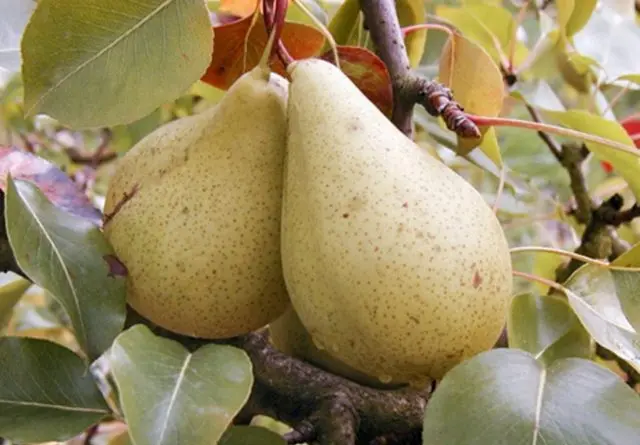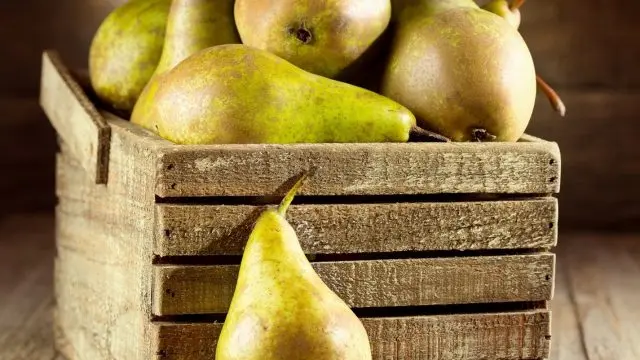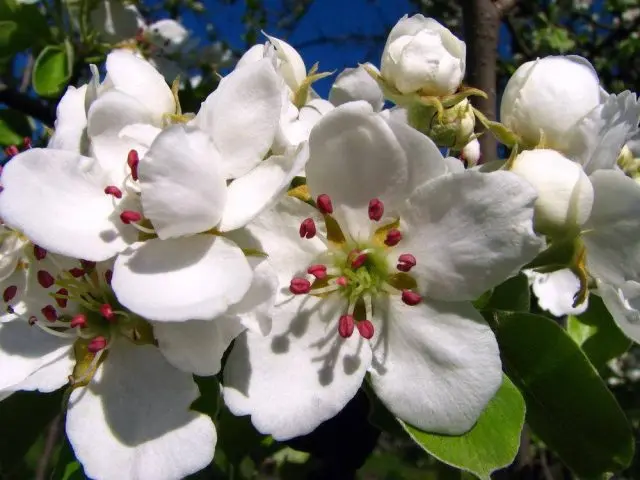Contents
In search of information about the qualities of the Cure pear variety, one can read conflicting articles. Description, photos and reviews of the Cure pear will help gardeners make a choice regarding this variety.
Description of the Cure pear variety
The popular Cure pear variety is also known under the names Pastorskaya, Winter large. The variety was accidentally discovered in the forest and cultivated in France over 200 years ago. In Our Country, officially established in 1947. Currently most common in the Southern regions:
- in the Astrakhan region;
- in the Kuban;
- in Dagestan;
- in the North Caucasus region.
A wild pear found in the forest turned out to be triploid – the number of chromosomes is 3 times higher than the norm for an ordinary pear. Such mutations have a positive effect on the rapid growth of the tree, fruit size and taste.

The now well-known variety is the result of crossing with the English variety Williams pears, it ripens by the beginning of winter, therefore it is also known as Cure Williams winter pear. A short description of the variety:
- The fruit tree of the Kure variety is durable, grows up to 5-6 m with a wide, dense crown of a pyramidal shape, reaching 4 m in width in adulthood.
- The trunk and skeletal branches at a young age have a smooth structure and gray color. With age, the bark stiffens, cracks and becomes darker.
- The shoots grow at an acute angle to the trunk, but during fruiting, under the weight of the fruit, they bend down. The leaves are small, dense, smooth, dark green in color with pronounced notches along the edges.
- Cure variety blooms in early spring, with abundant white flowers with pink anthers.
Characteristics of pear fruit
The Cure variety is grafted on wild game and quince. Fruiting begins quite early:
- on quince – from 4-5 years;
- on wild pear rootstocks – from 5-6 years.
Speaking about the size of the fruits, we can say that they are medium (150-200 g) and large (200-250 g), elongated pear-shaped, slightly asymmetrical, have a distinctive feature of the Cure pear, which can be seen in the photo – a brown threadlike strip extending from the stalk to the calyx.

The skin of the fruit is dense, thick, with frequent dark specks. Before maturing it has a light green color. When ripe, it becomes whitish-yellow. The pulp is white, sometimes with a light cream shade, fine-grained, tender, juicy, slightly sweet, has no pronounced taste and smell. For taste, on a 5-point scale, she received 3,5 points. The assessment was negatively affected by the astringent taste of the fruit and hard graininess near the seed lobules.
The fruits hang firmly on the branches in bunches with the help of slightly curved medium-sized stalks. Fruits should be removed 2-3 weeks before full ripening, as the shelf life is short – 1,5-2 months. Fruits tolerate transportation well. When ripe, their taste improves. Pears are consumed fresh and used for processing into compotes, jams, marmalade, dried fruits.
The characteristic of Cure pear fruits was appreciated by nutritionists. They recommend this variety to those who have problems with the digestive tract for its beneficial effect on the digestive system, high content of vitamin P and low calorie content – 6,5 g of sugar per 100 g of fruit.
Pros and cons of Cure
Cure pear has a number of advantages for which this variety is accepted for cultivation in industrial plantations:
- intermittent but high yield;
- large fruits;
- good winter hardiness and drought resistance;
- low demands on growing conditions;
- high regenerative capacity;
- excellent transport tolerance.
The existing shortcomings did not allow the Kure variety to become the most chosen among gardeners, but they mainly relate to fruits:
- do not have high taste;
- have a short shelf life;
- Fruit shrinks as yield increases.
It is noted that under adverse climatic conditions (low temperatures, lack of heat, high humidity), the tree is weakly resistant to scab.

Optimal growing conditions
The Cure pear variety is considered southern, but subject to certain conditions necessary for its cultivation, it can successfully bear fruit in regions with a temperate climate. Considered to be winter and drought tolerant as it easily recovers from bad weather conditions.
The sun for the Cure pear variety is essential to increase sugar content and improve palatability. If the sun and heat were not enough, then the fruits will be unsweetened and tasteless. Therefore, the Cure pear is planted in a well-lit area without strong winds and drafts.
Planting and caring for Cure pear
Although it is believed that this variety is undemanding to the composition of the soil, it grows and bears fruit better on light loamy soils. It is also necessary when planting to track that the roots do not get wet due to the proximity of groundwater.
Cure pear care is required, but it is normal and nothing special. It includes:
- watering;
- top dressing;
- pruning;
- mulching of the near-stem circle and its loosening;
- shelter for the winter and the adoption of protective measures in case of return frosts in the spring.
Rules of landing
Cure pear varieties are planted according to the same rules as all other representatives of this crop. It is only necessary to take into account the size of an adult tree in the future and for full development, plant according to the scheme 4,5-5 m between bushes, 5,5-6 m between rows.
Watering and top dressing
Watering for a pear should be regular. The tree tolerates drought well, and can quickly recover from a lack of water, but it needs moisture for rich fruiting.
Fertilization favorably affects the quantity and taste of fruits. Therefore, you can fertilize with standard complex fertilizers and humus. In autumn, with prolonged dry weather, the pear is plentifully watered and phosphate fertilizers are applied. In the spring – nitrogen fats, and in early summer they are fed with potash supplements.
Trimming
Pear Cure needs sanitary pruning, which is best done in the spring before the start of sap flow. Damaged and dry branches should be removed, and at the same time frostbitten ones, if such appeared during the winter.
Together with sanitary pruning, thinning of the crown is recommended. Since the Cure pear has a dense crown, a decrease in the number of branches will have a positive effect on the yield and taste of the fruit.
Whitewash
Pear is whitened in spring and autumn in order to protect against pests. Insect larvae and fungal spores living in the bark die after whitewashing. Use lime or water-based paint. Whitewashing is carried out up to about 1 m from the ground.
Preparation for winter
The Kure variety is winter-hardy and tolerates short frosts well. But if it happens that the tree is frozen, it takes a break in fruiting and quickly recovers.
In areas with severe frosts, it is recommended to insulate the trunks and root system for the winter, using building insulation, spruce branches, dry leaves and grass.
Pollination
The pollen of Cure pear flowers is sterile, which means that the tree is self-fertile. For pollination, it is recommended to plant varieties nearby:
- Bere Bosk;
- Clapp’s favorite;
- Olivier de Serre;
- Decan winter;
- Saint-Germain;
- Williams.

Productivity
Cure pear yield is high. In industrial plantations, it reaches 150-180 c/ha. Fruiting begins at 4-5 years and every year the yield increases. In the Kuban, 25-year-old pears yield 250 centners per hectare, and 30-year-olds – up to 500 centners per hectare.
The tree is considered long-term. It blooms early in spring, and the fruits ripen only in late September – early October. They must be taken unripe. Overripe pears have an unpleasant taste.
How to store curé pears
One of the disadvantages of the variety is that after ripening, the fruits quickly deteriorate. Therefore, they are plucked unripe and dried well in natural conditions before storage.
The storage area should also be clean, well ventilated, dry, dark and cool. Optimum temperature – 00C, humidity – from 80 to 85%. Ventilation of the room will extend the shelf life of fruits.
Storage boxes must be disinfected and dried. Pears are laid out in rows, which are sprinkled with a layer of dry straw or shavings.
Under such conditions, the fruits may lie unspoiled until the end of winter. They tolerate transportation well, but only in a state of incomplete maturation.
Diseases and pests
Scab is considered the main disease to which the pear has reduced immunity. It is noticed that it strikes a tree in a cold rainy summer. For prevention in spring and autumn, trees are sprayed with special fungicides.
If, nevertheless, dirty brown spots of a fungal disease appear on the leaves, and on the fruits, in addition to spots, there are also cracks, then the plant should be treated with fungicides “Skor”, “Merpan”, “Horus” and others before and after flowering. And also according to a special scheme in 10-12 days.
Pear Cure Reviews
Conclusion
Description, photos and reviews of the Cure pear indicate that this variety is worth the attention of those gardeners who want to grow it because of its high yield. In combination with unpretentiousness to environmental conditions, the Cure variety can be safely recommended for planting in industrial plantations.









